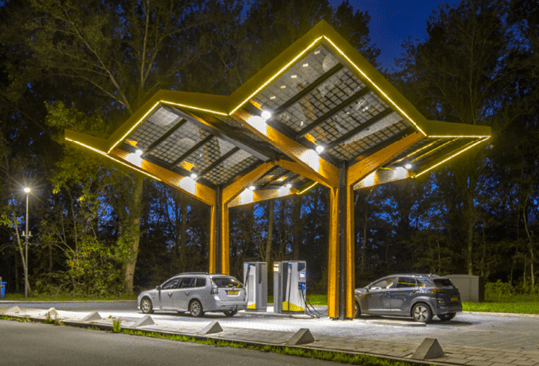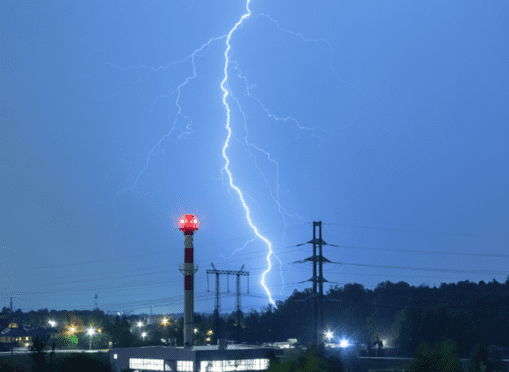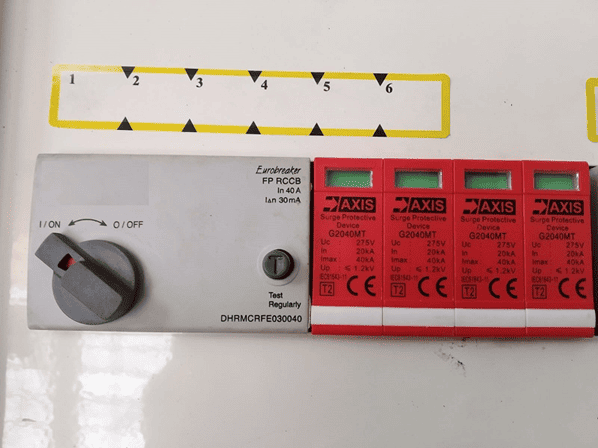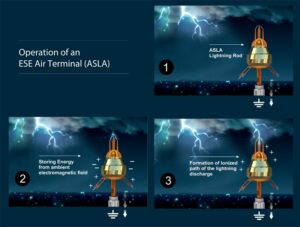In this blog, we will understand the surge risks faced in EV charging stations and the process of choosing the right Surge Protector Devices for your EV Charging Station.
The surge risks associated with Electric Vehicle (EV) charging stations are an emerging concern as the adoption of EVs accelerates globally. Protecting these vital components of the EV ecosystem from overvoltages caused by lightning strikes and power fluctuations is crucial. This comprehensive guide explores the origins of surge risks, the impact of lightning strikes, the significance of Lightning Protection Levels (LPL), the process for selecting the right Surge Protection Device (SPD), and the installation procedures to safeguard EV charging stations effectively.
As electric vehicles (EVs) gain popularity, the charging infrastructure must evolve to meet higher demands. A crucial aspect of this infrastructure is surge protection. Overvoltages, primarily caused by lightning strikes and power fluctuations, can severely damage the electronic components of EVs and charging stations. Implementing effective surge protection measures is not just a safety protocol; it’s an investment in the longevity and reliability of the entire EV ecosystem.

Overvoltages in electric vehicle (EV) charging infrastructure can occur due to several reasons:
- Lightning Strikes: Direct or nearby lightning strikes can induce high-voltage surges in the power lines, leading to overvoltages in the charging infrastructure.
- Power Fluctuations: Variations in the electrical grid, such as switching operations or faults, can result in sudden changes in voltage levels, causing overvoltages.
- Induction from Other Lines: Overvoltages can also be induced in charging infrastructure through electromagnetic induction from nearby power lines or lightning strikes.
- Short Circuits and Earth Faults: These electrical faults within the power network or within the charging system itself can cause abrupt voltage spikes.
- Grid-Side Electrical Switching Operations: Routine operations like the switching on/off of large electrical loads or faults in the electrical network can introduce overvoltages.
Effects of Lightning on EV Charging Stations

Lightning strikes pose one of the biggest risks to EV charging stations and vehicles due to their ability to generate extremely high voltages, which can lead to severe overvoltages in the electrical infrastructure. When lightning strikes, it can induce a surge of thousands of volts, far exceeding the tolerance levels of electronic components in EVs and charging stations.
This can result in immediate and significant damage to sensitive equipment, such as control systems, charging components, and vehicle batteries. The risk is compounded because EV charging often involves outdoor exposure, increasing the likelihood of being affected by lightning. Surge Protector Devices (SPDs) are crucial in these scenarios to dissipate the high energy from lightning strikes safely, protecting the EV charging infrastructure and vehicles from catastrophic damage.
Lightning Protection Levels
Lightning Protection Levels (LPL) are a crucial concept in the field of lightning protection and surge protection, particularly in relation to infrastructure such as EV charging stations. They are defined in the International Electrotechnical Commission (IEC) standard 62305. LPLs categorize the severity and potential impact of lightning strikes, helping in the design and implementation of protection systems. There are four LPLs – LPL I to LPL IV. Each level corresponds to a different level of lightning protection, with LPL I providing the highest level of protection and LPL IV the least.
Let’s understand the Criteria for LPLs. The determination of an appropriate LPL for a particular structure or system depends on several factors, including the structure’s location, its importance, the consequences of a lightning strike (like life hazard, and economic impact), and the environment.

- Relation to EV Charging Stations: For EV charging stations, selecting the appropriate LPL is crucial because it determines the level of protection needed against lightning-induced surges. A higher LPL (like LPL I or II) would be required for critical installations where a lightning strike could have severe consequences, while a lower LPL might be sufficient for less critical installations.
- Impact on Surge Protection: The chosen LPL directly influences the design of the surge protection system. It dictates the parameters for the SPDs (Surge Protection Devices) used, such as their energy handling capacity, response time, and clamping voltage. The higher the LPL, the more robust the SPD needs to be.
- Technical Aspects: SPDs for higher LPLs are designed to handle higher surge currents and faster transients. They typically have lower clamping voltages and faster response times to protect against the more severe surges expected under higher LPL conditions.
Talk to our engineers!
Parameters to Select Surge Protector Devices

a) Risk Assessment
The first step is assessing the specific risks associated with the location. This includes evaluating the likelihood of lightning strikes and the vulnerability of the electrical infrastructure to power surges. Different geographical locations have varying levels of lightning activity, which significantly influences the selection of the SPD.
b) Lightning Protection Levels (LPL)
Based on the risk assessment, the appropriate Lightning Protection Level (LPL) is determined. LPLs are categorized from I to IV, with I being the highest protection level. The chosen LPL informs the necessary specifications for the SPD, such as its energy handling capacity and response time.
c) Type of SPD

There are different types of SPDs: Type 1, Type 2, and Type 3. For EV charging stations, usually, Type 1 and Type 2 are considered. Type 1 is used for protection against direct lightning strikes and is typically installed at the service entrance. Type 2 SPDs are used for protection against indirect surges and are installed close to the protected equipment.
d) SPD Specifications
Key specifications for SPDs include the maximum continuous operating voltage, nominal discharge current, and the device’s clamping voltage. The SPD should be capable of handling the expected surge currents while maintaining a voltage level that the charging station’s equipment can tolerate. The nominal discharge current indicates the SPD’s capacity to handle surge current under standard test conditions.
e) Compliance with Standards

Ensuring that the SPD complies with relevant safety and performance standards is crucial. Standards like IEC 61643-11 provide guidelines for the performance and testing of SPDs. Compliance with these standards ensures that the SPD will perform effectively and safely.
f) Location of Installation
The effectiveness of an SPD is also influenced by its location. Ideally, SPDs should be installed as close as possible to the point where the power supply enters the charging station. This placement ensures that the surge is intercepted and dissipated before it can reach and damage the sensitive electronic components of the charging station.
g) Integration with Existing Infrastructure
The chosen SPD must be compatible with the existing electrical infrastructure of the EV charging station. This includes considerations like the electrical system’s voltage level, the nature of the grounding system, and the overall design of the electrical installation.
By taking these factors into account, the right SPD for an EV charging station can be selected, providing effective protection against surge-related damages and ensuring the reliability and longevity of the charging infrastructure.
Installation of Surge Protector Devices (SPDs)

- Site Evaluation: Begin with a thorough assessment of the site, considering factors like the frequency of lightning and the nature of power disturbances in the area.
- Selection of SPD: Based on the site assessment, select an SPD that meets the required specifications. This includes the type of SPD (Type 1, Type 2, or a combination), its voltage protection level, and its discharge capacity.
- Positioning the SPD: Ideally, install the SPD as close as possible to the point where the power supply enters the charging station. This minimizes the path of the surge and increases the effectiveness of the SPD.
- Integration with Electrical System: Ensure the SPD is integrated correctly into the charging station’s electrical system. This involves proper wiring and grounding in accordance with electrical codes and standards.
- Testing and Commissioning: After installation, the SPD should be tested to verify that it is functioning correctly and effectively mitigating surge risks.
- Regular Maintenance: Implement a schedule for regular inspection and maintenance of the SPD to ensure its long-term effectiveness and reliability.
Conclusion
Ensuring the longevity and reliability of EV charging stations through effective surge protection is paramount in the expanding electric vehicle market. By understanding the sources of surge risks, selecting appropriate Lightning Protection Levels, and implementing the right Surge Protection Devices, stakeholders can mitigate the potential for damage. This proactive approach not only protects the investment in EV infrastructure but also contributes to the overall safety and efficiency of the electric vehicle charging network, fostering confidence in this green technology’s future.
Thank you for reading the blog, Axis is a leading manufacturer and supplier of Electrical Components to over 80+ Countries. Talk to our industry expert by visiting our Contact Us section. You can also watch our videos by our experts – click here.






